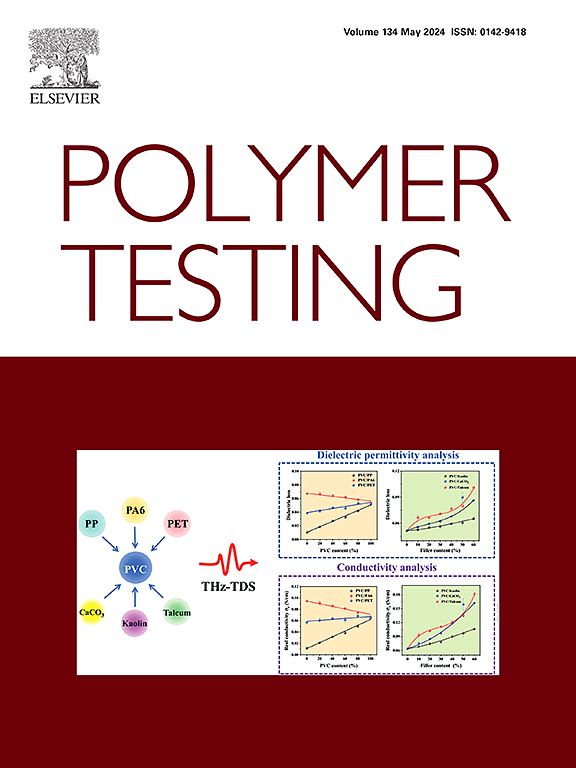Europium-labelled nanopolystyrene as model nanoplastics for environmental fate investigations: Synthesis and optimisation
IF 6
2区 材料科学
Q1 MATERIALS SCIENCE, CHARACTERIZATION & TESTING
引用次数: 0
Abstract
Nanoplastics (NPLs) have emerged as pervasive environmental contaminants, reaching remote regions and even crossing biological barriers such as the human blood-brain barrier. Their biomolecule-like composition, primarily composed of carbon and hydrogen, complicates detection using conventional analytical methods. To overcome this challenge, a tracer-doped plastic matrix was developed to enable rapid and precise detection, tracking, and analysis of NPLs. In this study, europium (Eu), a rare-earth metal, was used to label polystyrene-based NPLs, chosen for their abundance in environmental samples. The NPLs were synthesised through a two-step dispersion polymerisation process involving styrene (monomer), potassium persulfate (initiator), sodium dodecyl sulfate (surfactant), and Eu (dopant). Response Surface Methodology with Central Composite Design (RSM-CCD) was employed to optimise the synthesis parameters, and ANOVA confirmed the model's significance and robustness. The suitability of the labelling technique was confirmed by measuring the Eu-doped NPLs using single-particle inductively coupled plasma mass spectrometry (SP-ICP-MS). The results demonstrated a strong linear relationship between the concentration of Eu dopant, the total mass of the Eu-doped NPLs, and the number of individual Eu-doped NPL particles. Under optimised conditions the NPLs achieved a hydrodynamic size of 121.47 ± 0.89 nm and a dopant concentration of 0.12 wt%. Leaching tests conducted over seven days in deionised water (DIW) and artificial seawater (ASW) showed less than 0.5 % dopant loss, indicating robust encapsulation of Eu within the polymer matrix. This labelling approach provides a reliable method for the quantitative analysis of NPLs, enabling more accurate assessments of their behaviour and toxicity in various environmental contexts.

铕标记的纳米聚苯乙烯作为环境命运研究的模型纳米塑料:合成和优化
纳米塑料(NPLs)已经成为普遍存在的环境污染物,可以到达偏远地区,甚至跨越生物屏障,如人类血脑屏障。它们的生物分子样成分,主要由碳和氢组成,使传统分析方法的检测复杂化。为了克服这一挑战,研究人员开发了一种掺示踪剂的塑料基质,以实现对不良贷款的快速、精确检测、跟踪和分析。在这项研究中,铕(Eu)是一种稀土金属,用于标记聚苯乙烯基不良贷款,选择聚苯乙烯基不良贷款是因为它们在环境样品中的丰度。NPLs通过苯乙烯(单体)、过硫酸钾(引发剂)、十二烷基硫酸钠(表面活性剂)和Eu(掺杂剂)两步分散聚合工艺合成。采用响应面法和中心复合设计(RSM-CCD)优化综合参数,方差分析证实了模型的显著性和稳健性。通过使用单粒子电感耦合等离子体质谱(SP-ICP-MS)测量eu掺杂的NPLs,证实了标记技术的适用性。结果表明,Eu掺杂物的浓度、Eu掺杂NPL的总质量和单个Eu掺杂NPL粒子的数量之间存在很强的线性关系。在优化条件下,NPLs的水动力尺寸为121.47±0.89 nm,掺杂浓度为0.12 wt%。在去离子水(DIW)和人工海水(ASW)中进行了为期7天的浸出测试,结果显示,掺入剂的损失小于0.5%,这表明铕在聚合物基体中的包封性很强。这种标签方法为不良贷款的定量分析提供了可靠的方法,能够更准确地评估其在各种环境背景下的行为和毒性。
本文章由计算机程序翻译,如有差异,请以英文原文为准。
求助全文
约1分钟内获得全文
求助全文
来源期刊

Polymer Testing
工程技术-材料科学:表征与测试
CiteScore
10.70
自引率
5.90%
发文量
328
审稿时长
44 days
期刊介绍:
Polymer Testing focuses on the testing, analysis and characterization of polymer materials, including both synthetic and natural or biobased polymers. Novel testing methods and the testing of novel polymeric materials in bulk, solution and dispersion is covered. In addition, we welcome the submission of the testing of polymeric materials for a wide range of applications and industrial products as well as nanoscale characterization.
The scope includes but is not limited to the following main topics:
Novel testing methods and Chemical analysis
• mechanical, thermal, electrical, chemical, imaging, spectroscopy, scattering and rheology
Physical properties and behaviour of novel polymer systems
• nanoscale properties, morphology, transport properties
Degradation and recycling of polymeric materials when combined with novel testing or characterization methods
• degradation, biodegradation, ageing and fire retardancy
Modelling and Simulation work will be only considered when it is linked to new or previously published experimental results.
 求助内容:
求助内容: 应助结果提醒方式:
应助结果提醒方式:


